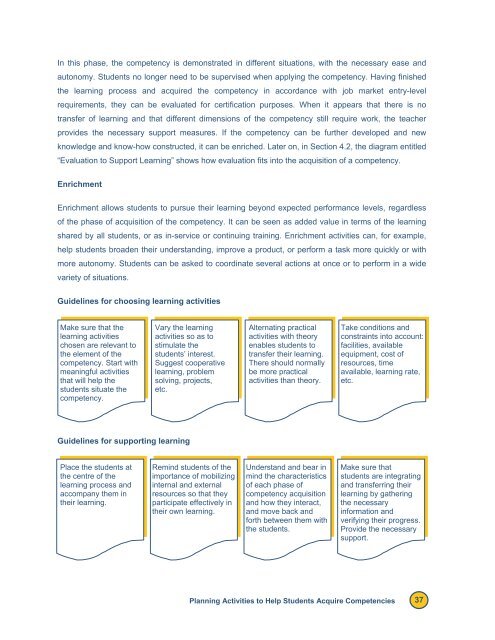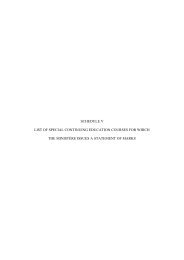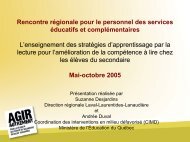Reference Framework for Planning Learning and Evaluation Activities
Reference Framework for Planning Learning and Evaluation Activities
Reference Framework for Planning Learning and Evaluation Activities
Create successful ePaper yourself
Turn your PDF publications into a flip-book with our unique Google optimized e-Paper software.
In this phase, the competency is demonstrated in different situations, with the necessary ease <strong>and</strong><br />
autonomy. Students no longer need to be supervised when applying the competency. Having finished<br />
the learning process <strong>and</strong> acquired the competency in accordance with job market entry-level<br />
requirements, they can be evaluated <strong>for</strong> certification purposes. When it appears that there is no<br />
transfer of learning <strong>and</strong> that different dimensions of the competency still require work, the teacher<br />
provides the necessary support measures. If the competency can be further developed <strong>and</strong> new<br />
knowledge <strong>and</strong> know-how constructed, it can be enriched. Later on, in Section 4.2, the diagram entitled<br />
“<strong>Evaluation</strong> to Support <strong>Learning</strong>” shows how evaluation fits into the acquisition of a competency.<br />
Enrichment<br />
Enrichment allows students to pursue their learning beyond expected per<strong>for</strong>mance levels, regardless<br />
of the phase of acquisition of the competency. It can be seen as added value in terms of the learning<br />
shared by all students, or as in-service or continuing training. Enrichment activities can, <strong>for</strong> example,<br />
help students broaden their underst<strong>and</strong>ing, improve a product, or per<strong>for</strong>m a task more quickly or with<br />
more autonomy. Students can be asked to coordinate several actions at once or to per<strong>for</strong>m in a wide<br />
variety of situations.<br />
Guidelines <strong>for</strong> choosing learning activities<br />
Make sure that the<br />
learning activities<br />
chosen are relevant to<br />
the element of the<br />
competency. Start with<br />
meaningful activities<br />
that will help the<br />
students situate the<br />
competency.<br />
Vary the learning<br />
activities so as to<br />
stimulate the<br />
students’ interest.<br />
Suggest cooperative<br />
learning, problem<br />
solving, projects,<br />
etc.<br />
Alternating practical<br />
activities with theory<br />
enables students to<br />
transfer their learning.<br />
There should normally<br />
be more practical<br />
activities than theory.<br />
Take conditions <strong>and</strong><br />
constraints into account:<br />
facilities, available<br />
equipment, cost of<br />
resources, time<br />
available, learning rate,<br />
etc.<br />
Guidelines <strong>for</strong> supporting learning<br />
Place the students at<br />
the centre of the<br />
learning process <strong>and</strong><br />
accompany them in<br />
their learning.<br />
Remind students of the<br />
importance of mobilizing<br />
internal <strong>and</strong> external<br />
resources so that they<br />
participate effectively in<br />
their own learning.<br />
Underst<strong>and</strong> <strong>and</strong> bear in<br />
mind the characteristics<br />
of each phase of<br />
competency acquisition<br />
<strong>and</strong> how they interact,<br />
<strong>and</strong> move back <strong>and</strong><br />
<strong>for</strong>th between them with<br />
the students.<br />
Make sure that<br />
students are integrating<br />
<strong>and</strong> transferring their<br />
learning by gathering<br />
the necessary<br />
in<strong>for</strong>mation <strong>and</strong><br />
verifying their progress.<br />
Provide the necessary<br />
support.<br />
<strong>Planning</strong> <strong>Activities</strong> to Help Students Acquire Competencies 37




